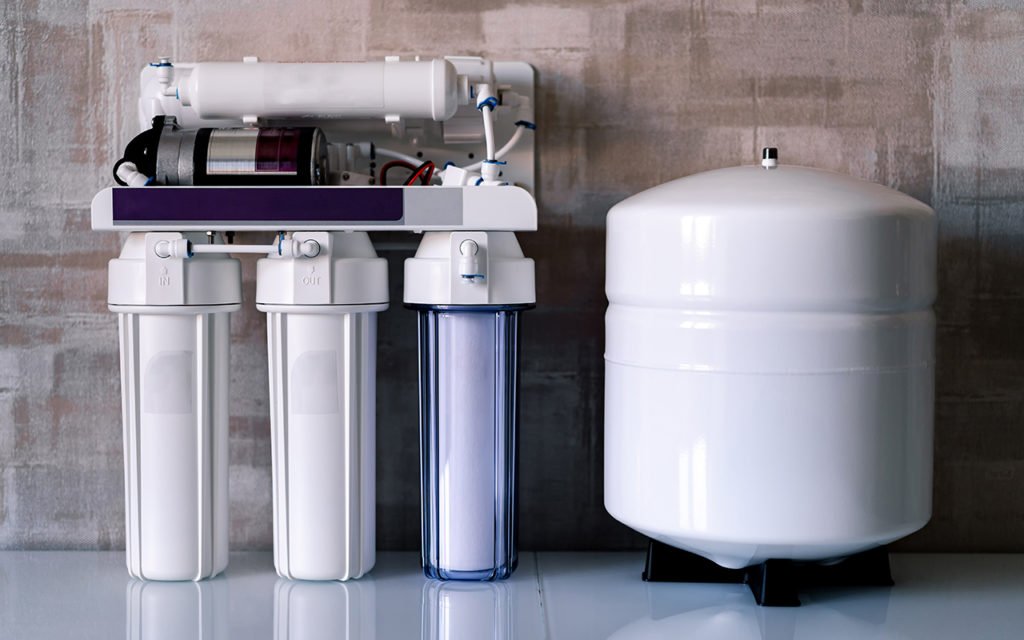
Many people decide to upgrade their home with Reverse Osmosis (RO) water filtration systems once they’ve learned of the benefits. Whether you want to know the health advantages of installing one in your own home, or get a better idea of how they create great tasting water, here is a deep dive into reverse osmosis systems.
Osmosis, as defined in chemistry according to Oxford Languages, is the process by which molecules of a solvent tend to pass through a semi-permeable membrane from a less concentrated solution into a more concentrated one, thus equalizing the concentrations on each side of the membrane.
So how does reverse osmosis apply to water purification in your home or business? Reverse Osmosis is very similar to the passive process already occurring in nature, but the primary difference is that reverse osmosis requires an active, external force to drive water through the semi-permeable membrane.
This type of filtration membrane blocks contaminants, both large and small, including particles, lead, mercury, chromium, and many others which are then flushed down the drain. A typical RO system also has a prefilter designed to capture larger particles such as chlorine and other substances, and an activated carbon filter that removes residual taste, odor, and some organic contaminants. Many RO units utilize 4 or 5 stage processes - the result is fresh, high-quality drinking water that’s collected in a holding tank ready for use
Most RO water filtration system processes can be broken down into four understandable steps:
1) Pre-filtration/ Sediment filtration phase reduces the number of fine particles that can clog the system and thus protect the RO’s membranes. This reduces particles like dirt, dust, and rust.
2) Water undergoes chlorine filtration since chlorine can damage the thin film material membranes of the RO system.
3) The third phase is a semi-permeable membrane that removes the majority of aesthetic and health-related contaminants.
4) The final phase is often a carbon post-filtration phase, acting as a final touch for aesthetics and odor contaminants.
What Are The Components Of A Reverse Osmosis System?
Common components of Reverse Osmosis Systems include:
Storage Tank: standard RO water tanks hold 2-4 gallons of water and are usually 12 inches by 15 inches in size.
Flow Restrictor: regulates flow to the membrane by maintaining flow rate and water pressure inside the membrane.
Drain Line: disposes of wastewater containing contaminants and impurities.
Cold Water Line Valve: water source for RO system.
Reverse Osmosis Membrane: the heart of the filtration system.
Pre and Post-Filter: filters (including carbon and sediment) that take place before or after the reverse osmosis membrane.
Automatic Shut Off Valve: conserves water by automatically shutting off the water source when storage is full.
Check Valve: prevents backflow of treated water from the storage tank.
According to the Water Quality Association, RO water does not pose any health concerns for healthy populations.
A common question is whether, with all this filtration, there are any beneficial nutrients removed during the process. It is true that dissolvable solids, including nutrients, are removed, but for people with an adequate amount of food, the minerals obtained through water are negligible in the bigger picture.
It is important to note that a RO system may not be able to sufficiently address water concerns related to PFOS and PFOA.
Although a Reverse Osmosis System provides great-tasting water, there are many more benefits to be found and considerations to be had.
A Reverse Osmosis system removes 98% of dissolved solids making it incredibly healthy to drink.
Reverse Osmosis systems can be installed individually or on a whole-home/ whole-building basis – these larger systems can lead to more challenges and bear the majority of disadvantages when considering a RO system. A whole-home/ building system is also known as a point-of-entry RO system.
Does a reverse osmosis water filtration system sound like an upgrade your home or business needs? Are you interested in getting delicious-tasting, healthy water for you, your family, and employees to enjoy? If you are in the Central Pennsylvania area – call WM Buffington! Our team of trained professionals can help with a new water filtration system and many other plumbing and heating needs.